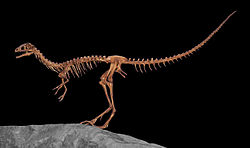
Back أنيق الفك Arabic Compsognatus Breton Compsognathus longipes Catalan Compsognathus CEB Compsognathus Czech Compsognathus Danish Compsognathus German Κομψόγναθος Greek Compsognathus longipes Spanish Compsognathus Basque
| Compsognathus Temporal range: Late Jurassic,
| |
|---|---|

| |
| Reconstructed skeleton at the Museum of Ancient Life | |
| Scientific classification | |
| Domain: | Eukaryota |
| Kingdom: | Animalia |
| Phylum: | Chordata |
| Clade: | Dinosauria |
| Clade: | Saurischia |
| Clade: | Theropoda |
| Family: | †Compsognathidae |
| Subfamily: | †Compsognathinae Cope, 1875 |
| Genus: | †Compsognathus Wagner, 1859 |
| Type species | |
| †Compsognathus longipes Wagner, 1859
| |
| Synonyms | |
| |
Compsognathus (/kɒmpˈsɒɡnəθəs/;[1] Greek kompsos/κομψός; "elegant", "refined" or "dainty", and gnathos/γνάθος; "jaw")[2] is a genus of small, bipedal, carnivorous theropod dinosaur. Members of its single species Compsognathus longipes could grow to around the size of a chicken. They lived about 150 million years ago, during the Tithonian age of the late Jurassic period, in what is now Europe. Paleontologists have found two well-preserved fossils, one in Germany in the 1850s and the second in France more than a century later. Today, C. longipes is the only recognized species, although the larger specimen discovered in France in the 1970s was once thought to belong to a separate species and named C. corallestris.
Many presentations still describe Compsognathus as "chicken-sized" dinosaurs because of the size of the German specimen, which is now believed to be a juvenile. Compsognathus longipes is one of the few dinosaur species whose diet is known with certainty: the remains of small, agile lizards are preserved in the bellies of both specimens. Teeth discovered in Portugal may be further fossil remains of the genus.
Although not recognized as such at the time of its discovery, Compsognathus is the first theropod dinosaur known from a reasonably complete fossil skeleton. Until the 1990s, it was the smallest-known non-avialan dinosaur, with the preceding centuries incorrectly labelling them as the closest relative of Archaeopteryx.
- ^ "Compsognathus". Oxford English Dictionary (Online ed.). Oxford University Press. (Subscription or participating institution membership required.)
- ^ Liddell, Henry George; Scott, Robert (1980) [1871]. A Greek-English Lexicon (abridged ed.). Oxford, United Kingdom: Oxford University Press. ISBN 978-0-19-910207-5.
© MMXXIII Rich X Search. We shall prevail. All rights reserved. Rich X Search